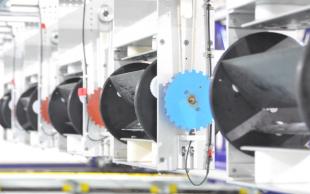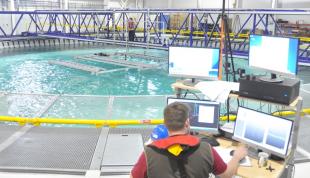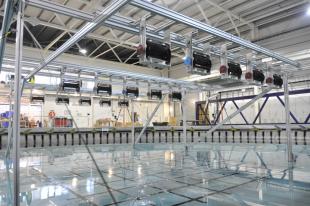Exeter and Edinburgh Universities test up to 15 device arrays in FloWave’s fast currents
An innovative new tidal turbine concept has been put through its paces after a rigorous eleven day test programme at the University of Edinburgh’s FloWave Ocean Energy Research Facility.
Up to fifteen scale models of the IP-protected MRL concept (Momentum Reversal Lift), were tried in a range of array configurations to determine the optimal set-up for maximum energy capture.
The FloWave tests come at the end of a three and a half year £1.12 million EPSRC-funded collaborative project led by Exeter University in partnership with Edinburgh and Manchester Universities.
The prototypes have been designed to operate on the seabed in estuaries, with long horizontal blades in a cylindrical ‘combine harvester’ design. Each blade has an aerofoil cross-section which changes its orientation as the machine rotates in order to maximize energy capture from the estuary flow. As part of the project the MRL concept was initially tested in a French laboratory, courtesy of support from the EC-FP7 MaRINET programme. However, conducting a second set of testing at FloWave has enabled considerably larger array layouts to be tested and a higher quality dataset to be captured, not least due the very large test section of the FloWave tank.
“The FloWave test programme has been fantastic,” says Ian Moon, Laboratory Technician from Exeter University, who manufactured the scale models and supervised all test activities.
“We were able to use real data from the FloWave test tank and compare this with the predictions from CFD modelling. This allowed us to make some immediate changes to the numerical model based on these results, and we have now captured a tremendous amount of high quality data which we can use to further refine the CFD models.
“The test programme has given us increased confidence in the MRL concept, and the team at FloWave could not have been more enthusiastic or helpful in supporting this test campaign. The facilities and support at FloWave are truly world class.”
Commenting on the successful conclusion of the test campaign FloWave Chief Executive Officer Stuart Brown said: “It has taken some considerable effort from all the collaborators on this project to achieve the test campaign on time, on budget and on quality, but I am really pleased that the group have been able to bring all their turbines to FloWave to be tested in a wide variety of numbers and configurations simply not possible elsewhere.
“I’d like to take this opportunity to thank the FloWave Engineering team for their input too: they designed, built and installed the frame to house the turbines in a multitude of different configurations, and even in the fastest currents deflection was sub-millimeter. The test clients now have a wealth of data collected covering a range of array layouts and configurations and we look forward to the profusion of academic papers that the campaign will inevitably generate.
“Once again FloWave shows that it is the most capable tank and team in the world for this kind of research and myself and the team look forward to welcoming Exeter University and a host of other institutions and research groups to the facility through 2016 and beyond.”
The MRL team will now write up the final results of their programme for submission to the EPSRC in 2016.





